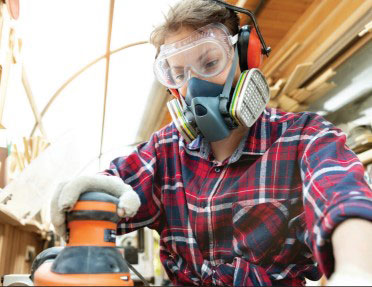Efforts are being made to attract more women into the construction and mining sectors to help address national shortages but is better education the key to encourage more female apprentices?
By Tracey Porter
Laura Wallmeyer knows better than to look a gift horse in the mouth.
When in year 10 her father afforded her the chance to leave school and begin a painting and decorating apprenticeship, she leapt at it.
Years later when working as a subcontract painter for a Geelong staircase company, she again took the bull by the horns by convincing the company’s owner to take her on as firstly his labourer and latterly his joinery apprentice. Wallmeyer, now 28, says while she was happy to be counted among the handful of female workers in the painting industry, she was eager to challenge herself by attempting another trade.
“I love painting and never lost my passion for it, but I felt I needed a change and being able to have the skill set that joinery provides is something that will benefit me for the rest of my career,” she says.
With more than 60 trades now listed on The National Skills Needs List, governments, industries and education providers have been attempting to overcome skills shortages in the manual trades by encouraging more women to pursue these careers.
As one of only around 5500 females working in manual trades in the building and construction, maintenance and renovation industries, Wallmeyer considers herself lucky to have two different trades behind her. Historically, organisations in these industries have struggled to not only attract women to consider and apply for jobs, they have also faced challenges in retaining the women who have chosen to work with them.
Currently participation of women as apprentices or trainees in the non-traditional trades, especially the core trades of construction, automotive and electrical sits at less than two per cent—a figure that has changed little over the past 25 years.
Tradeswomen Australia (TWA) managing director Fiona McDonald says there are numerous reasons why female participation rates in the trades remains so low with “historic gender discrimination barriers, a lack of promotion of trades at school level, and in some cases, a lack of knowledge by parents” all playing a part.
A 2019 report by TWA found employers in the male-dominated trades sector showed little support and encouragement for women wishing to enter an apprenticeship.
“The employer’s approach is driven by embedded ‘old’ attitudes, coupled with concerns about situations that may arise (with male workers) in the workplace. This reluctance, and lack of support, generally becomes a major influencing factor, discouraging women from ‘intruding’ into male dominated sectors (e.g. building and construction) regardless of the fact there are sound economic, skills shortage and capability reasons for a reversal of attitude,” the report noted.
Wallmeyer says education across the board—industry, educational institutions and advisors, and even tradeswomen
themselves—has been lacking but remains key to encouraging more women to take on a trades apprenticeship.
“I had no idea at school that doing an apprenticeship was even an option for me. Also, the perception of the industry with the whole male dominated culture could be off-putting and intimidating to some girls, especially if they are still school aged and looking to get into a trade,” she says.
Wallmeyer’s employer, Coastal Staircases director Kris Arends, agrees there is a lot the construction sector could do to attract more female workers into construction.
Arends says changing males’ prejudices and sexism, female-only trade school classes, site/factory visits for high school students together with an apprenticeship wellbeing officer who rings/visits people to help with issues such as bullying or abuse are all tactics that could help improve the longstanding gender imbalance in trades. But there is reason for hope.
The NSW Government’s fee-free Built For Women training program, Victoria’s Women Onsite program and the Females in Trades (FIT) initiative in Queensland are bringing visibility to the issue and helping to recruit more women to the sector.
National data from Construction Skills Queensland (CSQ) reveals Australian female construction apprentices more than doubled in the last decade from 1361 in December 2010 to 2929 in 2020.
The overall number of women in construction roles increased by 34 per cent in five years, from 44,583 in 2015 to 59,587 in 2020.
Female tradies too are doing their bit to ensure women remain a key part of such workplaces, with organisations such as the Tradie Lady Club (TLC), BUSY Sisters in Trades and Supporting and Linking Tradeswomen (SALT) set up solely to offer support and mentorship to female tradies.
Wallmeyer has been a part of TLC, started by carpenter Stefanie Apostolidis, almost from its inception three years ago. She says aside from the networking opportunities and support offered by such organisations, she enjoys feeling she is doing her bit to spread awareness and create equal opportunities for other women.
“I love following along on their journeys and giving as much support and encouragement as I can. It gives us girls a huge confidence boost being able to see other females in trades absolutely smashing it day in and day out.”
For his part, Arends says intelligent apprentices who display a willingness to learn and a personality that suits the company culture will always find employment—no matter their gender. “By encouraging more women to take up apprenticeships we won’t resolve the skill shortage but recruiting from a pool that is double the size of the traditional pool can only improve the problem. With more apprentices available, the overall standard in building quality will improve.
“I think some employers may be biased towards males, rather than females, due to factors such as strength, maternity leave, sexism in the workplace, relationships, etc., but I would rather have a reliable and interested female than a male who isn’t,” he says.






